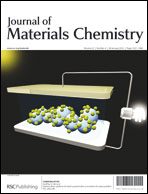A novel reinforcing porous substrate that features unprecedented capability of offering proton conductivity is demonstrated for potential use in a reinforced composite proton exchange membrane. The unusual porous substrate (hereinafter, referred to as “sPI substrate”) is composed of 3-trihydroxysilyl propane-1-sulfonic acid (THSPSA)-based silicate coating layers and electrospun polyimide (PI) nonwoven fibers. The THSPSA coating layers bearing sulfonic acid groups endow the sPI substrate with strong affinity for water molecules and also afford appreciable proton conductivity. Another distinctive characteristic of the sPI substrate is the nanoarchitectured structure of the THSPSA coating layers (shell) that encapsulate the PI nonwoven fibers (core). As a result, the core–shell structured sPI substrate maintains a highly porous structure, which plays a crucial role in providing effective proton-conducting channels after the impregnation of a polymer electrolyte (herein, sulfonated poly(arylene ether sulfone) (SPAES)). Notably, owing to the assistance of the proton-conductive sPI substrate, the sPI substrate-reinforced SPAES composite membrane presents higher proton conductivity than a PI nonwoven-reinforced SPAES composite membrane under various relative humidity (RH) conditions. This intriguing proton conductivity behavior is discussed based on an in-depth understanding of the unique core–shell structure and functionality of the sPI substrate and, moreover, is quantitatively interpreted by estimating theoretical proton conductivities predicted from series and parallel two-layer models.

You have access to this article
 Please wait while we load your content...
Something went wrong. Try again?
Please wait while we load your content...
Something went wrong. Try again?


 Please wait while we load your content...
Please wait while we load your content...